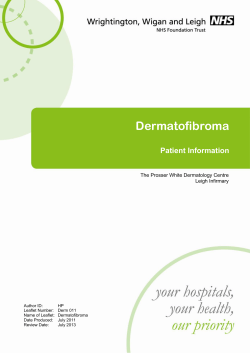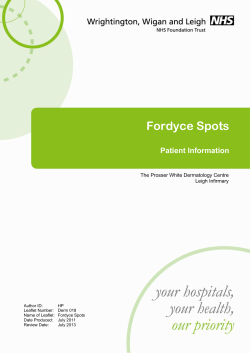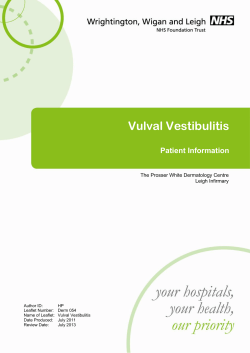
What is Evidence-Based Medicine? Volume 1, number 2
Volume 1, number 2 What is Evidence-Based Medicine? Sponsored by an educational grant from Aventis Pharma Jonathan Belsey MB BS Independent Medical Adviser and Tony Snell MB ChB DRCOG MRCGP Medical Adviser, East Kent Health Authority ● The primary purpose of the NHS is ‘… to secure, through resources available, the greatest possible improvement in the physical and mental health of the [population]’.1 To achieve this, decisions about the delivery and provision of healthcare are increasingly being driven by evidence of clinical and costeffectiveness as well as systematic assessment of actual health outcomes. ● Evidence-Based Medicine (EBM) is the process of systematically reviewing, appraising and using clinical research findings to aid the delivery of optimum clinical care to patients.2 ● Increasingly, purchasers are looking to the strength of scientific evidence on clinical practice and cost-effectiveness when allocating resources. They are using this information to encourage GPs and NHS trusts to adopt more clinically effective and costeffective practices. ● EBM forms part of the multifaceted process of assuring clinical effectiveness, the main elements of which are: – Production of evidence through research and scientific review. – Production and dissemination of evidence-based clinical guidelines. – Implementation of evidence-based, cost-effective practice through education and management of change. – Evaluation of compliance with agreed practice guidance and patient outcomes – this process includes clinical audit. www.evidence-based-medicine.co.uk Abbreviated prescribing information is on page 5 1 What is EBM? The logic behind EBM To make EBM more acceptable to clinicians and to encourage its use, it is best to turn a specified problem into answerable questions by examining the following issues: ● ● ● ● Person or population in question. Intervention given. Comparison (if appropriate). Outcomes considered. For example: Is an elderly man given nicotine patches more likely to stop smoking than a similar man who is not? Next, it is necessary to refine the problem into explicit questions and then check to see whether the evidence exists. But where can we find the information to help us make better decisions? The following are all common sources: ● Personal experience – eg, a bad drug reaction. ● Reasoning and intuition. ● Colleagues. ● Bottom drawer (pieces of paper lying around the office, etc). ● Published evidence. It is only by concentrating on the final category that ineffective, dangerous or costly interventions can be reduced. Analysing information In using the evidence it is necessary to: ● Search for and locate it. ● Appraise it. ● Store and retrieve it. ● Ensure it is updated. ● Communicate and use it. Every clinician strives to provide the best possible care for patients. However, given the multitude of research information available, it is not always possible to keep abreast of current developments or to translate them into clinical practice. One must also rely on published papers, which are not always tailored to meet the clinician’s needs. Forms of evidence Evidence is presented in many forms, and it is important to understand the basis on which it is stated. The value of evidence can be ranked 2 according to the following classification in descending order of credibility: I. Strong evidence from at least one systematic review of multiple well-designed randomised controlled trials. II. Strong evidence from at least one properly designed randomised controlled trial of appropriate size. III. Evidence from well-designed trials such as non-randomised trials, cohort studies, time series or matched case-controlled studies. IV. Evidence from well-designed non-experimental studies from more than one centre or research group. V. Opinions of respected authorities, based on clinical evidence, descriptive studies or reports of expert committees. Critical appraisal For any clinician, the real key to assessing the usefulness of a clinical study and interpreting the results to an area of work is through the process of critical appraisal. This is a method of assessing and interpreting the evidence by systematically considering its validity, results and relevance to the area of work considered. The Critical Appraisal Skills Programme, based at the Oxford Institute of Health Services, helps health service professionals and decision-makers develop skills in appraising evidence about clinical effectiveness. Its process uses three broad issues that should be considered when appraising a review article: ● Are the results of the review valid? ● What are the results? ● Will the results help locally? Meta-analyses Sometimes research findings may contradict each other and obscure the true picture – this is particularly the case with small trials. However, by pooling together all the results of various research studies, the sample size can, in effect, be increased. This is known as meta-analysis. Although pooling together the results of a number of trials will provide a greater weight of evidence, it is still important to examine meta-analyses critically:3 What is EBM? ● Was a broad enough search strategy used? MEDLINE, for instance, covers only about a quarter of the world’s biomedical journals. ● Do the results all or mostly point in the same direction? A meta-analysis should not be used to produce a positive result by averaging the results of, say, five trials with negative and ten trials with positive findings. ● Are the trials in the meta-analysis all small trials? If so, be very cautious. Practical examples of EBM EBM is not a purely academic or financial exercise – its implementation has major clinical implications that can save lives. 1. Deep vein thrombosis and pulmonary embolism Deep vein thrombosis (DVT) of the lower limb and pulmonary embolism are major causes of death and disability; clinically recognised DVT and/or pulmonary embolism occurs in about 2/1,000 persons each year. It is estimated that postsurgical DVT and pulmonary embolism cost the NHS in excess of £200m each year. Despite the fact that the major risk factors for DVT (age, immobility and certain forms of surgery) are well known, only 46% of high-risk patients receive any form of perioperative prophylaxis.4 Subcutaneous heparin has, in recent years, become the prophylactic treatment of choice for surgical procedures, based in part on the findings of a systematic review of the evidence.5 By comparing results from over 70 clinical trials of heparin, the authors were able to demonstrate a substantial benefit in patients undergoing general, orthopaedic and urological surgery. Based on this calibre of evidence, the Thromboembolic Risk Factors (THRIFT) Consensus Group6 recommends the following measures for prophylaxis: ● All hospital inpatients: – Should be assessed for clinical risk factors and overall risk of thromboembolism. – Should receive prophylaxis according to degree of risk before discharge. ● Low-risk patients: – Should be mobilised early. ● Moderate- and high-risk patients: – Should receive specific prophylaxis. – Should be mobilised early. 3 ● Clinicians, units and hospitals: – Should develop written policies for prophylaxis. – Should include prophylaxis in clinical audit and patient care plans. ● Efficacy of prophylactic methods: – Should be assessed in outpatients. More recently, studies have suggested that the use of low molecular weight heparin (LMWH) could be associated with an improved outcome, compared with unfractionated heparin. The higher unit cost of LMWH, however, means that healthcare purchasers have queried whether this benefit is real and its magnitude sufficiently great to warrant the additional investment. A further systematic review7 has confirmed not only that LMWHs are effective prophylactic agents in postoperative thromboembolic disease but that they are significantly more effective in preventing DVTs than standard forms of heparin. Indeed, an economic evaluation of the use of one LMWH (enoxaparin, ClexaneTM) in elective hip replacement8 estimates that a net saving of £20 could be made for every patient treated prophylactically with the LMWH. This increased efficacy, combined with ease of administration on an outpatient basis, promises considerable savings in secondary care expenditure. 2. Influenza vaccination Significant hospitalisation and 3–4,000 deaths are attributed to influenza each year in the UK. More than 85% of these deaths are people over 65 years, and in epidemic years the death toll is even higher. In addition, people with underlying chronic conditions are at higher risk of serious illness or death through influenza. A comprehensive review,9 based on a comparison of 8,000 vaccinated and 20,000 unvaccinated patients, indicated that the influenza vaccine is highly effective and that cases of respiratory illness, pneumonia, hospitalisations and mortality were reduced by over 50% in institutionalised elderly people. It recommends that people over 65 should be considered for influenza vaccination and that, in particular, those with chronic disease and resident in nursing and residential homes should be targeted. What is EBM? Sources of information There are many sources of information to inform clinical practice, and a full reference pack has been produced by the NHS Executive.10 Some sources are listed here: 1. The Cochrane Collaboration – an international endeavour in which people from many different countries systematically find, appraise and review available evidence from randomised controlled trials (RCTs). There are two components of the Cochrane Collaboration: Cochrane Centres (currently ten worldwide) and Collaborative Review Groups. The UK Cochrane Centre issues four regularly updated databases on CD-Rom, available from BMJ Publishing: ● The Cochrane Database of Systematic Reviews (CDSR). ● The York Database of Abstracts of Reviews Of Effectiveness (DARE). ● The Cochrane Controlled Trials Register (CCTR). ● The Cochrane Review Methodology Database (CRMD). 2. The NHS Centre for Reviews and Dissemination (CRD), based at the University of York, produces: – Effective Health Care bulletins, based on a series of systematic reviews and synthesis of research on clinical and cost-effectiveness. – Effectiveness Matters bulletins, summarising the results of important systematic reviews of research on specific clinical topics. – Systematic Reviews of Research Evidence – CRD reports. 3. The National Research Register – a database of information about research and development projects relating to the NHS. Available to all through the Department of Health and on the DOH website. 4. The NHS R&D Programme has a standing group on Health Technology Assessment that reports on the effectiveness of the latest health technologies. Each regional office has a brief to set up advisory groups and implement the R&D priorities identified as part of the national programme. 5. The Centre for Evidence Based Medicine at the University of Oxford, the Clinical Effectiveness Group for Wales based in Cardiff and the Clinical Resources and Audit Group (CRAG) at the Scottish Office in Edinburgh provide advice on various effectiveness matters. 6. MEDLINE and EMBASE – electronic databases drawing data from key publications worldwide. Available at most medical libraries, on CD-Rom or via the Internet. 7. An increasing range of journals and periodicals, including Bandolier, British Medical Journal, Journal of Evidence Based Medicine and Health Trends. 8. The National Primary Care Research and Development Centre in Manchester – a collaboration between the Universities of Manchester, Salford and York disseminating research on primary care policy and practice. References 1. Department of Health. Promoting clinical effectiveness: a framework for action in and through the NHS. London: DoH, 1996. 2. Rosenberg W, Donald A. Evidence-based medicine: an approach to clinical problem solving. BMJ 1995; 310(6987): 1122–1126. 3. Oxman AD et al. Users’ guides to the medical literature, VI. How to use an overview. JAMA 1994; 272(17): 1367–1371. 4. Griffin J. Deep Vein Thrombosis and Pulmonary Embolism. London: Office of Health Economics, 1996. 5. Collins R et al. Reduction in fatal pulmonary embolism and venous thrombosis by perioperative administration of subcutaneous heparin. N Engl J Med 1988; 318: 1162–1173. 6. Thromboembolic Risk Factors (THRIFT) Consensus Group. Risk of and prophylaxis for venous thromboembolism in hospital patients. BMJ 1992; 305: 567–574. [THRIFT II due for publication.] 7. Leizorovicz A et al. Low molecular weight heparin in prevention of perioperative thrombosis. BMJ 1992; 305: 913–920. 8. Drummond M et al. Economic evaluation of standard heparin and enoxaparin for prophylaxis against deep vein thrombosis in elective hip surgery. Br J Surg 1994; 81: 1742–1746. 9. NHS Centre for Reviews and Dissemination, University of York. Influenza vaccination and older people. Effectiveness Matters 1996; 2(1). 10. Department of Health Reference Pack. Clinical Effectiveness. London: DoH, 1996. 4 What is EBM? Abbreviated prescribing information: Clexane® Presentation: Clear, colourless to pale yellow solution of 100mg enoxaparin sodium per 1mL (anti-factor Xa activity of 10,000IU/mL with reference to the WHO First International LMW Heparin Reference Standard). Cartridges: single dose prefilled syringes fitted into a cartridge containing either: 20mg enoxaparin sodium in 0.2mL (2,000IU) or 40mg enoxaparin sodium in 0.4mL (4,000IU) The cartridge is to be fitted into the Clexane® Auto-Injector. 100 mg/mL prefilled syringes: single dose prefilled syringes containing either: 20mg enoxaparin in 0.2mL (2,000IU) or 40mg enoxaparin in 0.4mL (4,000IU). Indications: Prophylaxis of thromboembolic disorders of venous origin, in particular those associated with orthopaedic or general surgery and in medical patients bedridden due to acute illness. Dosage & Administration: Patients with low to moderate risk of thromboembolism, eg general surgery, recommended dose of Clexane® is 20mg (2,000IU) once daily subcutaneously, the initial dose being given approximately 2 hours preoperatively. Patients with high risk of venous thromboembolism, eg orthopaedic surgery, the recommended dose is 40mg (4,000IU) once daily subcutaneously, the initial dose being given approximately 12 hours preoperatively. Clexane® should be continued for 7 to 10 days or until risk of thromboembolism has diminished. Medical patients bedridden due to acute illness, the recommended dose is 40mg (4,000IU) once daily for a minimum of 6 days until return to full ambulation, for a maximum of 14 days. Elderly: No dosage adjustment necessary. Children: Not recommended. Contraindications: Acute bacterial endocarditis, major bleeding disorders, thrombocytopenia in patients with positive in-vitro aggregation test in presence of Clexane®, active gastric/duodenal ulcer, hypersensitivity to enoxaparin, stroke (unless due to systemic emboli) and other patients with increased risk of haemorrhage. Warning: Clexane® must not be administered by the intramuscular route. Precautions: Clexane® should be used with care in hepatic insufficiency, history of thrombocytopenia, and conditions with increased bleeding potential. Different low molecular weight heparins may not be equivalent; alternative products should not be substituted during therapy. Heparins can suppress adrenal secretion of aldosterone leading to hyperkalaemia. Pregnancy: Clexane® should not be used during pregnancy unless no safer alternative is found. Lactation: Advise avoidance of breast-feeding. Interactions: Care in patients receiving agents affecting haemostasis, eg oral anticoagulants, thrombolytics, systemic glucocorticoids, NSAIDs, aspirin. Adverse Reactions: Bleeding in the presence of associated risk factors, rarely retroperitoneal and intracranial bleeding. Rarely thrombocytopenia, liver abnormalities (eg transaminases and alkaline phosphatase changes), allergic reactions. At site of injection: pain, haematoma, irritation, rarely hard inflammatory nodules and skin necrosis. Osteoporosis has not been reported with Clexane® but the risk cannot be excluded. Heparins can cause increase in plasma potassium, and rarely, clinically significant hyperkalaemia. Rare reports of intra-spinal haematoma when using spinal/epidural anaesthesia and post-operative indwelling catheter. Pharmaceutical Precautions: Do not mix with other injections or infusions. Clexane® cartridges: store at or below 25°C. Do not freeze cartridges. Prefilled syringes: do not store above 25oC. Do not refrigerate or freeze. Legal Category: POM; Clexane® cartridges PL 0012/0336, Clexane® 100 mg/mL prefilled syringes PL 0012/0196. Basic NHS cost for 10 cartridges: 20mg – £47.90, 40mg – £60.79. Basic NHS cost for 10 prefilled syringes: 20mg – £33.89, 40mg – £45.16. Full Prescribing Information and further information is available on request from Aventis Pharma, 50 Kings Hill Avenue, West Malling, Kent. ME19 4AH. Date of preparation: June 2000. ® denotes a Registered Trade Mark 5 Volume 1, number 2 What is EBM? This publication, along with the others in the series, is available on the internet at www.evidence-based-medicine.co.uk Any enquiries please contact: Team Assistant to the Health Economics Unit Aventis House Kings Hill West Malling Kent ME19 4AH Tel: 01732 584 254 Fax: 01732 584 029 Published by Hayward Medical Communications Ltd. Sponsored by an educational grant from Aventis Pharma CLE 049/05/01 Date of preparation: May 2001 6 Copyright © 2001 Hayward Medical Communications Ltd. All rights reserved. What is… ? Sponsored by an educational grant from Aventis Pharma ’What is…?’ bulletins faxback form fax no. 01732 584029 If you would like to receive more information about the What is… ? series simply print out this form, fill in your details and fax it to: Team Assistant to the Health Economics Unit, Aventis Pharma. Name: ____________________________________________________________________________ Position: ____________________________________________________________________________ Address: ____________________________________________________________________________ ____________________________________________________________________________ ____________________________________________________________________________ Postcode: _______________________________ (For mailing purposes a postcode must be supplied) Tel: _______________________________ Fax: ________________________________________ Email: ____________________________________________________________________________ www.evidence-based-medicine.co.uk
© Copyright 2025













